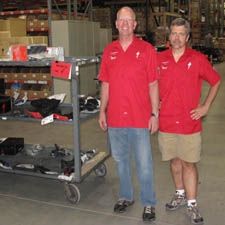SALT LAKE CITY, UT (BRAIN)—Kim Peterson is ready to leave this 200,000-square-foot warehouse that’s been Specialized’s distribution backbone in the West. But he still has a few more months to wait.
The California company, which has upwards of 60,000 bikes on hand, will move to a new distribution and service center about a mile away by year’s end, said Peterson, corporate distribution manager for Specialized.
Peterson, a bear of a man who sometimes is asked to try and “break” a few bikes, said the new facility, spread out over 250,000 square feet of fresh concrete with ample natural light, could be expanded in the future if needed.
As we walk through the warehouse, helmets, tires, accessories and row upon row of bikes are stacked so high they skim the metal roof. From here, the company can ship bikes and accessories with one-day delivery to upwards of 15 percent of its Western dealer base. Salt Lake is also a major trucking hub with competitive freight rates.
Specialized containers arrive at the Port of Long Beach from Asia and are shipped by rail to a nearby railhead. Trucks then move the containers to the warehouse.
Rick Peterson (no relation), who manages day-to-day operations in Salt Lake, supervises a staff of about 70 employees and manages the flow of inventory in and out of the complex.
Most dealers who place orders by 2 p.m. can expect the delivery truck to pull up two days later, Peterson said. Ironically, some 60 percent of the company’s Western dealers are in California. So why have a distribution center in Salt Lake?
The cost. Peterson said the square-foot cost to lease a facility this large is 30 percent less than similar space in California. “It’s a huge difference,” he said. At one time labor costs were also much lower in the Salt Lake area, but that gap is narrowing, he added. Workmen’s comp rates are lower, but health care premiums are higher.
Besides distribution, the facility handles warranty issues, customer service, random quality assurance checks, and is a repair center for suspension forks. Dealers ship forks in for repair and, in general, technicians complete the repairs and return them in 24 hours.
A major advantage for employees at the new center will be centralized offices with natural light flooding in from floor-to-ceiling windows. Currently, some employees work in a box-within-a-box and only see daylight when they take a break, leave for lunch or end the day, Petersen said.
Specialized moved into the building 10 years ago where it also painted and assembled bikes for several years.
—Marc Sani


